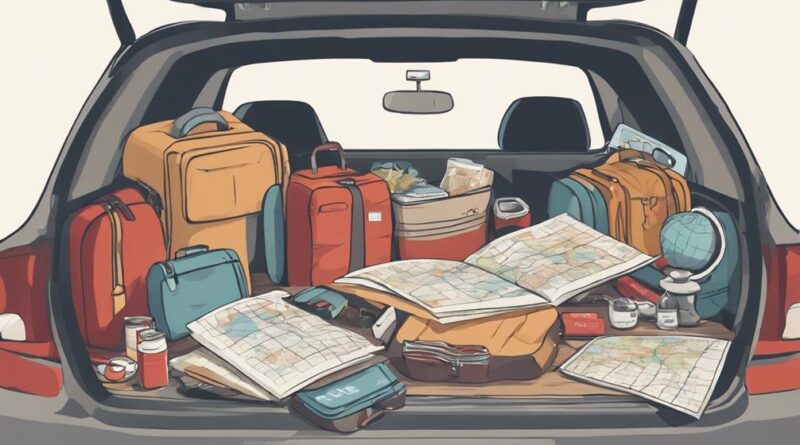5 Best Strategies for Long-Distance Road Trip Preparations
Before embarking on your next long-distance road trip, ensuring your vehicle is in top condition is crucial. From checking the tire pressure to inspecting the fluid levels, taking care of these basics can save you from potential breakdowns on the road.
But there's more to a successful journey than just vehicle maintenance. Stay tuned to discover other essential strategies that will make your road trip smoother and worry-free.
Vehicle Maintenance Checklist
Before embarking on your long-distance road trip, ensure your vehicle is in prime condition by following this maintenance checklist.
First and foremost, check your brake system to guarantee optimal performance during your journey. Make sure to inspect the brake pads and rotors for any signs of wear and tear. If you notice any squeaking noises or reduced braking efficiency, it may be time for a replacement. Additionally, check the brake fluid level and top it up if necessary to maintain proper braking function.
Next, conduct thorough engine diagnostics to prevent any unexpected breakdowns on the road. Check all fluid levels, including engine oil, coolant, and transmission fluid, and top them up as needed. Inspect the battery to ensure it's securely mounted and free of corrosion. Consider getting a professional engine tune-up to address any underlying issues and ensure optimal fuel efficiency.
Tire Care Tips
After ensuring your vehicle's brake system is in top-notch condition, shift your focus to maintaining proper tire care for a safe and smooth long-distance road trip. Keeping your tires in excellent shape is crucial for a hassle-free journey. Here are some essential tire care tips to consider:
- Check Tire Pressure Regularly: Proper tire pressure is vital for both safety and fuel efficiency. Before embarking on your long-distance road trip, ensure that your tires are inflated to the recommended pressure levels. You can find the correct tire pressure information in your vehicle's manual or on a sticker located inside the driver's side door.
- Inspect Tread Depth: Adequate tread depth is essential for good traction, especially in wet or slippery conditions. Use a tread depth gauge to measure the depth of the grooves in your tires. If the tread depth is worn down to 2/32 of an inch or less, it's time to replace the tires. Driving with worn-out treads can increase the risk of hydroplaning and loss of control.
- Rotate Tires: To ensure even wear and maximize the lifespan of your tires, consider rotating them regularly. Rotating tires helps distribute wear more evenly, extending their longevity and improving overall performance. Check your vehicle's manual for the recommended tire rotation schedule based on your driving habits.
Fluid Levels Inspection
Ensure that all essential fluids in your vehicle are at optimal levels by conducting a thorough inspection before embarking on your long-distance road trip. Proper fluid levels are crucial for maintaining your vehicle's fuel efficiency and engine performance throughout the journey.
Start by checking your engine oil using the dipstick. Make sure it's within the recommended range and appears clean, as dirty oil can lead to poor engine performance. Additionally, inspect the coolant level in the reservoir to prevent overheating, which can significantly impact fuel efficiency.
Don't forget to examine the transmission fluid to ensure smooth gear shifts and prevent potential transmission problems that could affect both fuel efficiency and engine performance. Brake fluid is equally important; low levels can compromise your braking system, impacting safety and fuel efficiency.
Next, check the power steering fluid to maintain easy maneuvering during the trip, enhancing both fuel efficiency and overall driving comfort. Lastly, inspect the windshield washer fluid to guarantee clear visibility at all times, contributing to safe driving practices and optimal fuel efficiency.
Emergency Kit Essentials
To prepare for unexpected situations on your long-distance road trip, gather essential items to create a comprehensive emergency kit. Being prepared can make a significant difference in handling any unforeseen events that may arise during your journey.
Here are some key items to include in your emergency kit:
- First Aid Kit: A first aid kit is crucial for addressing minor injuries and medical needs that may occur while on the road. Make sure it includes items like bandages, antiseptic wipes, pain relievers, and any specific medications you or your passengers may require.
- Emergency Contacts List: Compile a list of emergency contacts that you may need to reach out to in case of an accident or other emergencies. Include numbers for roadside assistance, your insurance provider, family members, and friends who can help in times of need.
- Flashlight and Batteries: In the event of a breakdown or driving at night, a flashlight can be invaluable. Ensure you have extra batteries or a rechargeable flashlight to avoid being left in the dark during emergencies.
Battery and Electrical Check
When embarking on a long-distance road trip, one essential aspect to address is conducting a thorough check of your vehicle's battery and electrical system to ensure a safe and smooth journey. Start by inspecting the battery for any signs of corrosion or leaks. If the battery is old or showing signs of deterioration, consider a replacement to prevent unexpected breakdowns during your trip.
Additionally, test the alternator to ensure it's charging the battery properly. A malfunctioning alternator can lead to a drained battery and cause your vehicle to stall.
Before setting off on your journey, it's crucial to verify that all electrical components are functioning correctly. Check the headlights, taillights, turn signals, and brake lights to guarantee they're illuminating properly. Faulty lights can reduce visibility and pose a safety hazard, especially during night driving or inclement weather.
Moreover, test the windshield wipers, air conditioning, and heating systems to ensure they're in good working condition for a comfortable ride.
Packing Efficiently
Optimize your luggage arrangement for your upcoming long-distance road trip to maximize space and organization efficiency. Packing efficiently can make a significant difference in the comfort and convenience of your journey.
Here are some tips to help you pack smarter:
- Roll Your Clothes: Rolling your clothes instead of folding them not only saves space but also helps prevent wrinkles, making it easier to find and access your outfits during the trip.
- Use Packing Cubes: Packing cubes are a fantastic organization hack to segment your belongings neatly within your luggage. They help separate different types of items, such as clothes, accessories, and toiletries, keeping everything in place.
- Invest in Multi-Functional Travel Accessories: Packing essentials like a versatile travel pillow that can double as lumbar support in the car or a portable charger that can power up multiple devices can save space and serve multiple purposes throughout your journey.
Navigation and Route Planning

Plan your road trip route strategically to ensure smooth navigation and efficient travel. Before hitting the road, make sure to input your destination into your GPS navigation system. Utilizing GPS navigation will help you stay on track and navigate unfamiliar roads with ease. Additionally, consider planning scenic detours along the way to make your journey more enjoyable and memorable.
When plotting your route, take into account any potential road closures, construction zones, or heavy traffic areas that could cause delays. Opt for main highways and interstates for faster travel times, but don't shy away from taking the occasional scenic route to break up the monotony of long drives. These detours can lead you to hidden gems and breathtaking views that you wouldn't have experienced otherwise.
Be flexible with your route planning, allowing room for adjustments based on real-time traffic updates or unexpected closures. Stay informed about weather conditions along your route and have alternative routes in mind in case you need to reroute due to roadblocks or adverse weather.
Safety Precautions
Prioritize your safety by ensuring your vehicle is properly maintained before embarking on your long-distance road trip. Regular maintenance checks such as oil changes, tire rotations, brake inspections, and fluid top-ups can prevent breakdowns and ensure your vehicle is in optimal condition for the journey ahead.
Safety Precautions:
- Driving Fatigue: Plan to take regular breaks every 2 hours or 100 miles to combat driving fatigue. Switch drivers if possible to stay fresh and alert behind the wheel.
- Roadside Assistance: Before hitting the road, make sure you have a roadside assistance plan in place. Services like AAA or your car insurance provider's emergency assistance can be invaluable in case of unexpected car troubles.
- Emergency Kit: Pack an emergency kit that includes items such as a first aid kit, flashlight, blankets, water, non-perishable snacks, and basic tools. Being prepared can help you handle minor issues and stay safe in case of emergencies.
Frequently Asked Questions
How Can I Stay Entertained During Long Hours of Driving on a Road Trip?
To keep entertained during long drives, try road trip games, podcast playlists, music mixes, and audiobooks. These options can make the journey more enjoyable and engaging.
Road trip games like 20 Questions or the License Plate Game can be fun distractions.
Podcast playlists and audio books offer interesting stories and information.
Music mixes can set the mood and keep you energized.
Experiment with different entertainment options to find what works best for you.
Are There Any Special Considerations or Tips for Traveling With Pets on a Long-Distance Road Trip?
When traveling with pets on a long road trip, consider pet-friendly accommodations and plan for rest stops. Pack pet travel essentials like food, water, toys, and a comfortable bed.
Take regular exercise breaks to stretch their legs and keep them happy. Make sure to secure your pet safely in the car and never leave them unattended.
Prioritize their comfort and safety to ensure a smooth journey for both of you.
What Are Some Ways to Save Money on Gas and Other Expenses During a Long Road Trip?
To save money on gas and expenses during a long road trip, consider budget-friendly accommodations and fuel-efficient driving techniques. Look for hotels with complimentary breakfast or camping options.
Drive at a steady speed, properly inflate your tires, and avoid sudden accelerations. Plan your route to minimize backtracking and use apps to find cheaper gas stations along the way.
These strategies can help you stick to your budget while enjoying your trip.
How Can I Ensure That I Stay Alert and Avoid Fatigue While Driving Long Distances?
To stay awake and safe while driving long distances, prioritize your driver wellness.
Take regular breaks to stretch, walk around, and stay hydrated. Avoid heavy meals and opt for light, healthy snacks to maintain energy levels. Consider switching drivers if possible to share the load.
Keep the car well-ventilated and play upbeat music to stay alert. Remember, your safety is paramount, so listen to your body and rest when needed.
Are There Any Specific Tips for Avoiding Traffic and Congestion on Popular Road Trip Routes?
When planning your road trip, consider using navigation apps to find alternate routes and avoid popular road trip congestion. Manage your time wisely by checking traffic patterns before you leave and planning rest stops strategically.
Navigation apps can help you stay updated on traffic conditions and suggest faster routes to your destination. By taking advantage of these tools, you can minimize the chances of getting stuck in traffic and enjoy a smoother journey.
Conclusion
In conclusion, by following these 5 best strategies for long-distance road trip preparations, you can ensure a smooth and enjoyable journey. Remember to check your vehicle maintenance, tire care, fluid levels, emergency kit, battery, and packing efficiency.
Plan your route ahead of time, pack smartly, and prioritize safety at all times.
With these tips in mind, you'll be well-prepared for any adventure on the open road. Happy travels!
